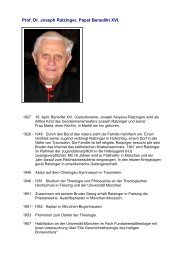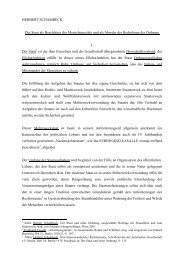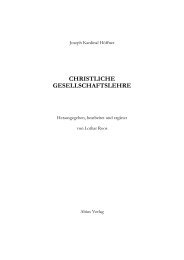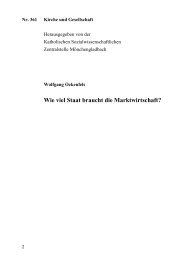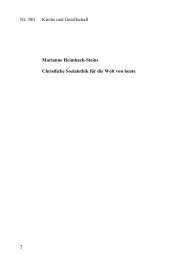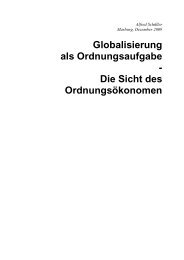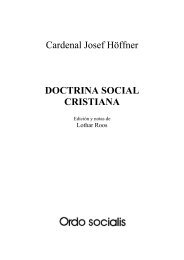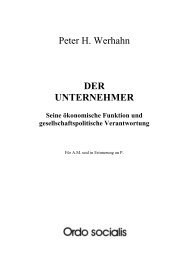Joseph Cardinal Höffner CHRISTIAN SOCIAL ... - Ordo Socialis
Joseph Cardinal Höffner CHRISTIAN SOCIAL ... - Ordo Socialis
Joseph Cardinal Höffner CHRISTIAN SOCIAL ... - Ordo Socialis
You also want an ePaper? Increase the reach of your titles
YUMPU automatically turns print PDFs into web optimized ePapers that Google loves.
their faith, as it were, in the political realm and act according to liberal or socialist models.<br />
Political activation marked by faith is allegedly ‘political clericalism’. To this insulting objection<br />
it is to be answered that in the modern ideologically pluralistic society the Christian is<br />
also entitled and obligated to co-operate in the political molding of the state, of the society,<br />
and of the economy from out of his or her faith. As the Second Vatican Council teaches,<br />
Christians should be a model of dutiful action and champion the common good. Through their<br />
deeds, they should show „how authority is to be harmonized with freedom, personal initiative<br />
with consideration for the bonds uniting the whole social body, and necessary unity with<br />
beneficial diversity“ (Gaudium et spes, 75). Here, however, a clear distinction must be made<br />
„between what a Christian conscience leads them to do in their own name as citizens, whether<br />
as individuals or in association, and what they do in the name of the Church and in union with<br />
her shepherds“ (ibid., 76).<br />
In modern society, the Church is only present and effective as far as the witness of Christians<br />
extends (Cf. ibid., 76), which must take effect „in the arena of their labor, profession, studies,<br />
residence, leisure, and companionship“ (Apostolicam actuositatem, l3). If this witness is lacking,<br />
the Church will no longer fill the spiritual space of society, and other forces will infiltrate,<br />
gain acceptance, and even shake the legally secured position of the Church in the state. If the<br />
substance of the faith is lacking, no state privileges can provide a substitution.<br />
SECTION FIVE: THE COMMUNITY OF NATIONS<br />
CHAPTER ONE: THE UNITY OF THE HUMAN RACE AS THE FOUN-<br />
DATION OF THE COMMUNITY OF NATIONS<br />
Whereas the animal world is divided into numerous genera and species, which frequently<br />
fight mercilessly against one another, humans are not only a biological unity, 75 but metaphysically<br />
united through the same human nature in spite of their differences in skin color and<br />
national characteristics. The inhumane limitation of ‘humanness’ to one’s own tribe, one’s<br />
own race, one’s own nation, or one’s own class leads to bestiality. Because humans are not<br />
only ‘many’, but ‘many of the same species’, they form an original, pre-existing unity in a<br />
spiritual-moral, legal, and economic respect, independently of their agreement and consent.<br />
§ 1 The Spiritual-Moral Unity of Mankind<br />
l. The orientation of all mankind towards the same spiritual-moral values of the true, the good,<br />
the beautiful, and the holy is given through the selfsame human nature which is identical in all<br />
people. The realization of these values takes places through the co-operation of all nations and<br />
cultural areas in world history.<br />
2. Because world economy and world trade, press and radio, threat of war and longing for<br />
peace have bound all mankind into a fateful unity as never before, the recognition of common,<br />
fundamental spiritual and moral values is more urgent today than in earlier periods, when continents<br />
and cultural areas were hardly in contact with one another. World peace has its deepest<br />
foundations neither in the system of bloc formations nor in the balance of arms, but in the<br />
spiritual unity of people and nations. Pius XII therefore exhorted: „Let the blockades be<br />
opened, let the wire entanglements be removed, let every nation be granted a free view into<br />
75 Jerome Lejeune writes: „All presently living people have the same chromosomes.“ From this it follows „that<br />
the caryotype...of man as we know him today originally made its appearance in a very limited group, perhaps in<br />
a single couple“ („Über den Beginn des menschlichen Lebens,“ in Die Herausforderung der Vierten Welt [Cologne,<br />
1973], 45).<br />
157




